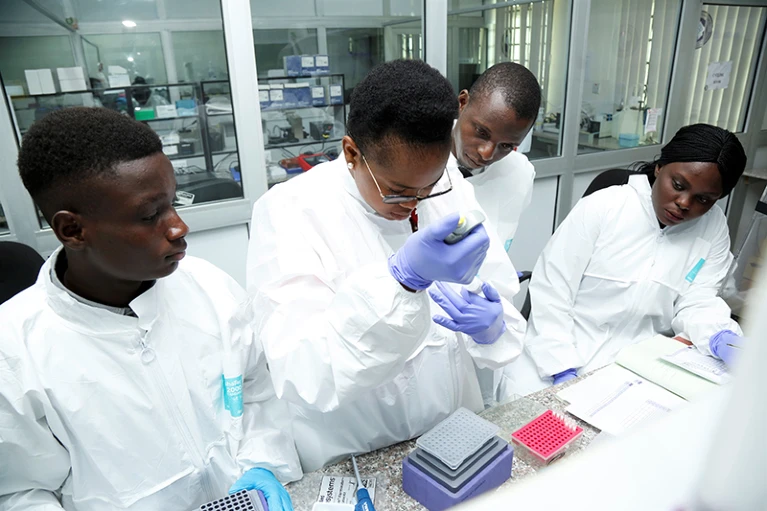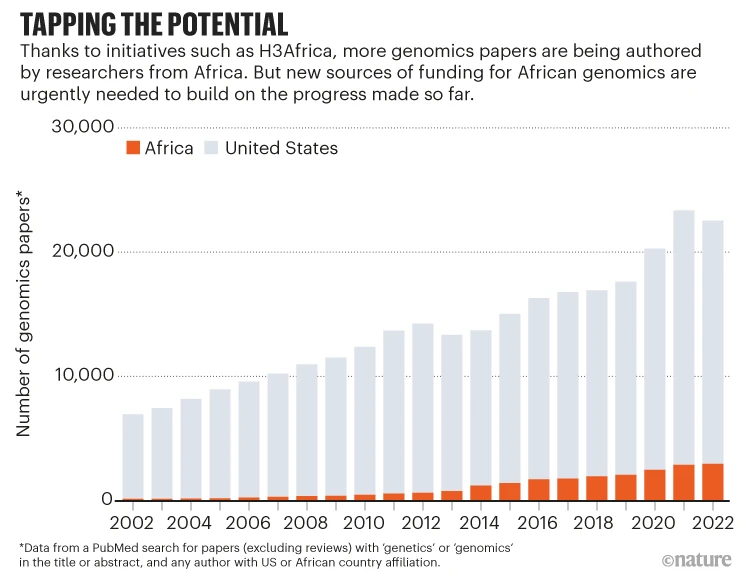Could Africa be the future for genomics research?
Funds for a major genomics programme in Africa will run dry this year. A chance to address global inequity in health-related genomics by building on the success of this initiative must not be missed.


Funds for a major genomics programme in Africa will run dry this year. A chance to address global inequity in health-related genomics by building on the success of this initiative must not be missed.

Scientists at the African Centre of Excellence for Genomics of Infectious Diseases in Ede, Nigeria, prepare samples for DNA sequencing.Credit: ACEGID
In 2020, an analysis of 426 African genomes, involving researchers from 15 African countries, uncovered 3 million new variants in the human genome. The discovery contributed to the development of a tool that enables researchers to identify genetic associations specifically in African populations — the Infinium H3Africa Consortium genotyping array, produced by the US biotechnology firm Illumina.
Although various enterprises have supported cutting-edge human genomics in Africa, the Human Heredity and Health in Africa (H3Africa) initiative, which supported this work, has probably contributed the most in terms of infrastructure and training. The US$176-million programme began in 2010, funded by the US National Institutes of Health (NIH) and the UK biomedical charity Wellcome (in partnership with the African Society of Human Genetics). Projects have ranged from population-based genomic studies of common disorders, such as heart disease, to investigations of infectious diseases, such as COVID-19. Together, some 51 projects, all led by African scientists and involving researchers from more than 30 African countries, have resulted in 50,000 samples being genotyped and nearly 700 papers being published.
Thanks to H3Africa and other genomics initiatives, such as the Nigerian 100K Genome Project, African genomics is now poised to improve the health of millions of people worldwide, including those across the continent and the African diaspora. But building on the discoveries made so far — and especially applying findings to the clinic — will require several systemic changes, including a major shift in how genomics research in Africa is funded.
All remaining projects supported by the H3Africa initiative are expected to wrap up this year. (Although funding formally ended in June 2022, some H3Africa grant recipients were able to obtain extensions because of disruption from the COVID-19 pandemic.) Here, we lay out what is needed to ensure that investment in genomics in Africa is not just sustained in a post-H3Africa world but expanded. In our view, Africa could become the birthplace for a new kind of genomics — one that brings better health to all.
As of 2021, nearly 86% of participants in genome-wide association studies (GWAS) worldwide were of European descent, even though that group makes up only 16% of the world’s population. (Such studies screen the genomes of thousands of people to establish whether a particular genetic variant is associated with a trait of interest.) This bias means that precision-medicine tools, such as polygenic risk scores — which use genetic data to predict a person’s risk of developing a certain disease — are much more accurate for people of European ancestry.
H3Africa has helped to address this inequity in at least five ways.
First, H3Africa has made it easier for Africans to pursue genomics on the continent (see ‘Tapping the potential’). This has been made possible through establishing sequencing facilities, including in South Africa, Gambia, Nigeria, Ethiopia, Uganda and Botswana, and setting up training programmes, for example in bioinformatics. Because African institutions were made the direct recipients of grants in the H3Africa programme, Africans have been able to design projects, training and infrastructure according to the needs of their own countries.

Source: PubMed/Analysis by Z. Lombard